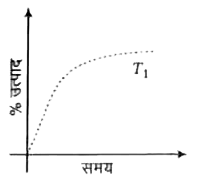For 2NH3(g)Pt−−−−−→Δ products follows zero order kinetics. If t1/2 at p = 4 atm is 25 sec, t1/2 at p = 16 atm will be (in sec)Solution in Telugu
6.25
625
100
(25)14
The correct Answer is:C
Step by step video, text & image solution for For 2NH_3(g) underset(Delta)overset(Pt)(to) products follows zero order kinetics. If t_(1//2) at p = 4 atm is 25 sec, t_(1//2) at p = 16 atm will be (in sec) by Chemistry experts to help you in doubts & scoring excellent marks in Class 12 exams.
Topper's Solved these Questions
- BOOK - AAKASH SERIESCHAPTER - CHEMICAL KINETICSEXERCISE - Objective Exercise - 3 (Previous NEET/AIPMT Questions)32videos
CHEMICAL KINETICS
- BOOK - AAKASH SERIESCHAPTER - CHEMICAL KINETICSEXERCISE - Objective Exercise - 4 (Assertion (A) & Reason (R) Type Questions)44videos
CHEMICAL KINETICS
- BOOK - AAKASH SERIESCHAPTER - CHEMICAL KINETICSEXERCISE - Objective Exercise - 1124videos
CHEMICAL KINETICS
- BOOK - AAKASH SERIESCHAPTER - CHEMICAL KINETCSEXERCISE - EXERCISE - 3.245videos
CHEMICAL KINETCS
- BOOK - AAKASH SERIESCHAPTER - CHEMICAL THERMODYNAMICSEXERCISE - Additional Practice Exercise54videos
CHEMICAL THERMODYNAMICS
Similar Questions
For a first order reaction A→B the reaction rate at reactant concetration of 0.01 M is found to be 2.0×10−5mol L−1s−1. The half life period of the reactionis
02:35View Solution(A) Spontaneous reaction may be slow or fast.
(R ) Spontaneous nature deals with feasibility of the reaction but not rate.00:59View SolutionWhich of the following reactions occurs at measurable rate?
View SolutionDiscuss on the kinetic spontaneity of a chemical reaction. Is a slow reaction spontaneous? Why?
03:26View SolutionWhich among the following is not an exact differential?
07:49View SolutionThe major product of the following reaction overset((1) t_(Bu) OK)underset((2) Conc. H_(2)SO_(4)//Delta)to
02:16View SolutionIf P is in equilibrium then T_(1)/T_(2) is
02:09View Solutiont_(x//y) = time in which x//y fraction of reactant converts into product. {:(,"Column-I",,"Column-II"),("(a)",t_(5//9),,(p)Equal t o 54 sec if t_(1//3) "is 18 sec in case of first order reaction"),("(b)",t_(19//27),,(q)Equal t o 32 sec if t_(1//14) "is 16 sec in case of first order reaction"),("(c)",t_(7//8),,(r)Equal t o 56 sec if t_(1//3) "is 4 sec in case of second order reaction"),("(d)",t_(7//16),,(t)Equal t o 30 sec if t_(1//3) "is 18 sec incase of zero order reaction"),(,,,(t)Equal t o 28 sec if t_(1//2) "is 16 sec in case of zero order reaction"):}
View SolutionFind the missing parameters.
P=1atmP=1atmP=1atmV1=0.3dm3V2=?V3=0.15dm3T1=200KT2=300KT3=?K02:19View SolutionThe tangents to the parabola y2=4ax at P(t1) and Q(t2) intersect at R. The area of Δ PQR is
01:23View Solutionअभिक्रिया, N2(g)+3H2(g)↔2NH3(g), ΔH<0 में अमोनिया के प्रतिशतता उत्पाद (% yield) की समय (time) पर निर्भरता (p,T1) पर नीचे दर्शाई गई है
यदि यह अभिक्रिया (p,T2) पर की जाए, जहाँ T2>T1, अमोनिया के % उत्पाद की समय पर निर्भरता प्रदर्शित करता है
 01:47View Solution
01:47View SolutionFor 2NH_(3)(g) overset(Pt)underset(Delta)to Products order kinetics. If t_(1//2) at p = 4 atm is 25 sec, t_(1//2) at p = 16 atm will be (in sec)
01:23View SolutionIf a reaction with t1/2=69.3 sec, has a rate constant 10−2sec−1, the order is
View SolutionIf 'P' is in equilibrium then T_(1)//T_(2) is
06:44View SolutionDecomposition of NH_3 on Pt surface follows zero order kinetics. If the initial pressure is 4 atm, the product of t_(1//2) and k equals to
03:04View Solution

